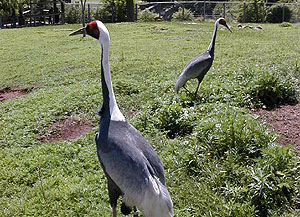|
Audio
Photos
Resources
Your Voice
|
West Nile at the Zoo
June 24, 2003
Zoo and wildlife managers are bracing for another season with West Nile virus. West Nile is a concern for public health officials and a headache for the state's zoos. Zoos have been scrambling to protect susceptible birds and animals, including some endangered species.
Duluth, Minn. — West Nile was identified three years ago in New York City. Since then, the virus has spread with alarming speed. Last year a few isolated cases reached Duluth. Lake Superior Zoo Director Mike Janis is anticipating many more cases this summer.
 | |||
"We're expecting this year to be the year it's going to hit us hard," Janis says. "So, we're expecting the worst this year, not only in our captive population, but also in the wild population up here."
The West Nile virus is transmitted by mosquitoes, but spread by infected, migrating birds. By last fall, West Nile had sickened almost fifty Minnesotans. But it killed dozens of horses and countless wild birds. Researchers don't know the long term effect on wild bird populations, but West Nile is known to hit some zoo animals hard.
The Milwaukee County Zoo lost more than a dozen penguins last year to West Nile. Raptors and owls seem particularly susceptible.
"In the State of Michigan last year (in a) twelve to fourteen day period in September and October, every snowy owl in captivity died from West Nile," Janis says.
 | |||
That was more than a dozen owls in zoos, nature centers and rehabilitation facilities. The Duluth Zoo's lone snowy owl has been immunized, in hopes of warding off West Nile.
So have the three bald eagles.
Lake Superior Zoo officials have innoculated raptors and ravens, and hoofed animals, including local favorite, Ashley the donkey.
The zoo is targeting standing water where mosquitoes might hatch. Animal water bowls are cleaned daily. Workers have patched holes in the walkway where water might collect.
"And after a rainstorm, some of our volunteers and summer help is going to be out there with pushbrooms, cleaning out, you know," Janis says. "Sweeping off the water from areas where it might puddle in a pothole or something like that."
 | |||
The Lake Superior Zoo's innoculated its white-naped cranes. They're an endangered bird native to North Korea, Manchuria, and Russia. If the vaccine works, these cranes should be OK, but Janis says endangered species outside zoos may not be so lucky.
"So, basically we doing the best that we can with what we've got," Janis says. "In the wild, there's virtually nothing that can be done for wild birds."
West Nile has already taken it's toll on the state's wild birds. Pat Redig Directs the University of Minnesota's Raptor Center.
"We had about 59 confirmed cases of it that came through our center here," Redig says. "Most of them in Great Horned owls. But as we look around this year, this spring, we can't detect that there's been a measurable impact on populations of birds at this stage of the game."
One problem is detection. Many smaller birds die unnoticed. Redig says there's barely time or money to diagnose dead animals, and none to study wild bird populations. And it would be impossible to vaccinate birds and other animals in the wild.
Meanwhile, the vaccine currently available was never intended for birds, according to Dr. Jim Rasmussen, Head Veterinarian at the Minnesota Zoo.
"The current West Nile vaccine that's available was licensed for use in horses, and we're using it in species that it hasn't been tested in," Rasmussen says.
"Anecdotally, the vaccine does seem to confer some protection, but it's certainly not one hundred percent effective."
There's a scramble on to develop a bird specific vaccine. Biologists want an effective tool before West Nile reaches the Southwest United States. That's where 80 endangered California Condors have been released, from a total population of just 200 birds.
A new experimental vaccine will be tried this year on red tailed hawks. But there's little hope for a widely distributed vaccine for the nation's zoo birds for at least a couple of years.
|
News Headlines
|
Related Subjects
|

